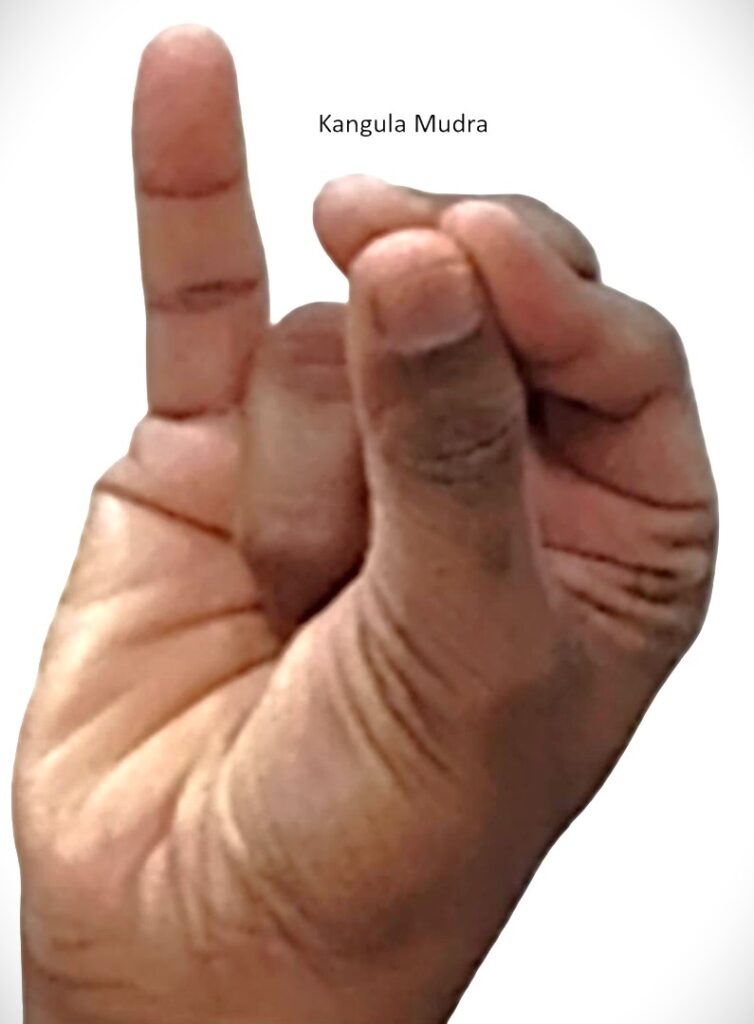Kangula Mudra
Introduction
Kangula Mudra is one of the lesser-known therapeutic mudras in yogic and ayurvedic traditions. It is primarily used to strengthen the little finger (Kangula), which represents the water element and is associated with the urinary and reproductive systems. In yoga mudra therapy, this mudra is recommended for conditions related to the kidneys, urinary bladder, prostate, uterus, and reproductive health. It also helps in improving vitality and restoring fluid balance in the body.
Meaning
Kangula = little finger (in Sanskrit).
Mudra = gesture, seal, or psychic posture.
Thus, Kangula Mudra means the “gesture of the little finger,” which harnesses the energy of the water element for healing, purification, and reproductive vitality.
How to Perform (Method of Practice)
Step-by-Step Instructions:
Sit in a comfortable posture such as Sukhasana, Padmasana, or Vajrasana with a straight spine.
Touch the tip of your Ring finger to the center point of your palm and press slightly.
Join the tips of your other four fingers together and extend them as upwards as possible.
Close your eyes, focus on slow deep breathing, and direct awareness to the urinary system or reproductive area.
Maintain the mudra for the desired duration.
Benefits
Physical Benefits:
Balances the water element in the body.
Improves the functioning of kidneys, bladder, uterus, and prostate.
Helpful in urinary tract infections, excessive urination, and incontinence.
Supports fertility and strengthens reproductive energy.
Reduces joint stiffness and lubricates tissues.
Mental & Emotional Benefits:
Calms emotional disturbances linked to fear and insecurity.
Promotes a sense of inner purity, fluidity, and adaptability.
Helps overcome suppressed emotions, particularly those connected with relationships.
Spiritual Benefits:
Awakens Swadhisthana Chakra (sacral energy center).
Enhances creativity and emotional harmony.
Purifies pranic flow through the water element channel (Jala Nadi).
Contraindications
Should be avoided during excessive water retention, swelling, or edema.
Not recommended for people with severe kidney failure without medical guidance.
Pregnant women should practice only under supervision.
Should not be practiced for too long in cases of low blood pressure.
Anatomy & Physiology
Finger Involvement: Little finger represents the water element and is linked to the excretory and reproductive organs.
Physiology: Activates urinary and reproductive pathways, regulates water metabolism, and supports endocrine functions (especially gonads).
Circulatory Effect: Improves hydration and nutrient transport at a cellular level.
Kinesiology
Involves flexion of the little finger and gentle pressure by the thumb.
Encourages relaxation of the forearm flexors and extensors.
Promotes a stable seated posture with balanced hand positioning.
Neurology
Stimulates the ulnar nerve (connected to the little finger), influencing motor control and sensory feedback.
Calms the autonomic nervous system by reducing stress signals from the bladder.
Supports parasympathetic activation, which aids in urinary and reproductive system balance.
Duration of Practice
Beginners: 10–15 minutes, 2–3 times daily.
Therapeutic Use: 20–30 minutes in divided sessions.
Spiritual Practice: Can be held during meditation for 30–45 minutes.
Best practiced on an empty stomach or during early morning or evening meditation.
Counter Mudra
Apana Mudra – for purification and elimination.
Varun Mudra – for overall water element balance and hydration.
Linga Mudra – as an opposite energizing mudra (fire element to balance excess water).
Conclusion
Kangula Mudra is a therapeutic hand gesture that activates the water element in the body, promoting health of the kidneys, bladder, and reproductive organs. It balances emotions, enhances creativity, and purifies the body’s energy system. When practiced regularly with mindful breathing, it brings physical healing, emotional clarity, and spiritual balance by harmonizing the Swadhisthana Chakra.
FAQ
Q1: What is Kangula Mudra best for?
It is best for urinary health, kidney balance, reproductive vitality, and emotional purification.
Q2: Can it cure urinary infections?
It may support healing, but should be practiced along with proper medical treatment.
Q3: Can children practice it?
Yes, for short durations (5–10 minutes), under guidance.
Q4: When should I avoid it?
Avoid during water retention, edema, or severe kidney failure.
Q5: Can it be combined with pranayama?
Yes, it works well with deep abdominal breathing or Ujjayi pranayama.
References
Swami Satyananda Saraswati – Asana, Pranayama, Mudra, Bandha.
Gertrud Hirschi – Mudras: Yoga in Your Hands.
Swami Niranjanananda Saraswati – Yoga Darshan.
B.K.S. Iyengar – Light on Yoga.
Research papers on mudra therapy and yogic healing of urinary disorders.

